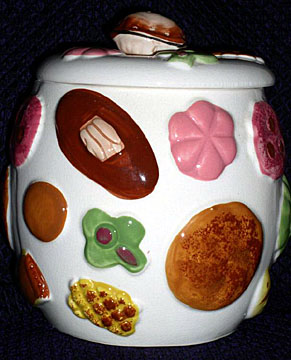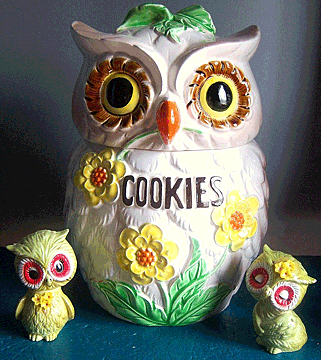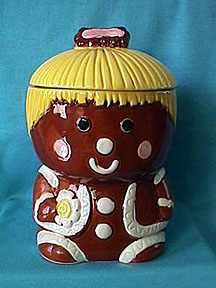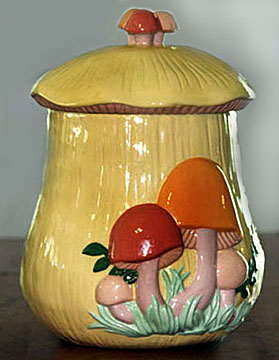Cookie Jars—Good as Gold
by Bob Brooke
 Today,
the term “cookie jar” refers to a folder in a computer that stores
“cookies,” or files containing information about the user for use by
online companies. But it’s the term’s more traditional use as a storage
container for delicious morsels of sweet goodness made by mothers and
grandmothers over the years that some collectors will give their eye
teeth–and sometimes their savings–to acquire. For cookie jars have
become as good as gold in the collectible market. Today,
the term “cookie jar” refers to a folder in a computer that stores
“cookies,” or files containing information about the user for use by
online companies. But it’s the term’s more traditional use as a storage
container for delicious morsels of sweet goodness made by mothers and
grandmothers over the years that some collectors will give their eye
teeth–and sometimes their savings–to acquire. For cookie jars have
become as good as gold in the collectible market.
During the late 18th and early 19th centuries, the British stored pieces
of shortbread in elegant covered jars made of cut glass with silver
lids. It’s from these early jars that the term “cookie jar” originated,
a name that has lasted until today.
But it was the American pottery jar that first became popular with
collectors at the beginning of the Great Depression in 1929. Shaped like
covered glass cylinders or pots with screw-on lids, these early cookie
containers were more utilitarian than decorative although makers often
painted them with floral or leaf motifs. Depression glass makers
produced cookie jars in just about every pattern.
The Brush Pottery Company of Zanesville, Ohio, produced the first
ceramic cookie jar, in green and with the word “Cookies” painted on the
front. The company marked their jars with “Brush USA” on the bottom. By
the mid-1930s, stoneware became the favored material for making American
cookie jars.
As the end of the 1930s decade dawned, most manufacturers were producing
ceramic cookie jars, and at the same time experimenting with innovative
forms and designs and decorative motifs. Cookie jars appeared in figural
shapes resembling fruits and vegetables, birds and animals, and fairy
tale characters such as Little Red Riding Hood.
 The
golden age of American cookie jars got underway in 1940. And by the
middle of the decade, many makers became inspired by popular cartoon and
comic book characters of the day–Superman, Mickey Mouse, Winnie the
Pooh, Dumbo, and Woody Woodpecker, to name a few. The
golden age of American cookie jars got underway in 1940. And by the
middle of the decade, many makers became inspired by popular cartoon and
comic book characters of the day–Superman, Mickey Mouse, Winnie the
Pooh, Dumbo, and Woody Woodpecker, to name a few.
The advent of popular kids’ television shows, like Howdy Doody, Yogi
Bear, the Lone Ranger, and others, in the early 1950s spawned yet
another set of characters. One of the most popular with collectors is a
jar shaped like Yogi Bear, based on the show which debuted in 1958.
Today, these same Yogi cookie jars, made by the American Bisque Co. of
Williamstown, West Virginia, can go for as much as $400 on eBay.
Beginning in the 1960s with Andy Warhol’s huge paintings of Campbell
Soup cans, pop art began to influence the design of cookie jars. Soon
jars like the one resembling the Beatles’ yellow submarine began to
appear.
And as the 1950s progressed into the 1960s, some manufacturers,
including Red Wing, Hull, Regal China, Metlox, Shawnee, Robinson-Ransbottom,
as well as McCoy and Brush, rose to prominence. Many had located in the
clay-rich Ohio River Valley.
Collectors love McCoy cookie jars, for example. The company, based in
Roseville, Ohio, produced cookie jars from about 1939 until 1987. Their
first jar–the “Mammy,” made to resemble a jolly black woman from the Old
South, complete with bandana and apron–is today one of the most
valuable. McCoy also turned out an assortment of fruit and vegetable
jars, and most are embossed with McCoy on the bottom.
Collectors also actively seek jars made by American Bisque of
Williamstown, West Virginia, which began producing cartoon character
cookie jars in the mid-1930s. The company marked its jars with “U.S.A.”
on the bottom.
Metlox of California, maker of the popular Little Red Riding Hood jar,
and the Abingdon Pottery of Illinois, maker of the Mother Goose jar
series are two other companies whose jars collectors seek.
 Today,
there are almost as many varieties of cookie jars as salt and pepper
shakers. A typical search for cookie jars on eBay can result in nearly
7,000 hits. Collectors can choose from old glass and ceramic jars, as
well as newer plastic ones. Besides the cartoon character jars that made
this collectible so popular, collectors can also choose from a myriad of
advertising jars for companies like Nabisco and Coca Cola. Christmas and
other holiday jars, as well as seasonal jars, are yet other variations. Today,
there are almost as many varieties of cookie jars as salt and pepper
shakers. A typical search for cookie jars on eBay can result in nearly
7,000 hits. Collectors can choose from old glass and ceramic jars, as
well as newer plastic ones. Besides the cartoon character jars that made
this collectible so popular, collectors can also choose from a myriad of
advertising jars for companies like Nabisco and Coca Cola. Christmas and
other holiday jars, as well as seasonal jars, are yet other variations.
But unlike salt-and-peppers, which can be displayed in a small area, the
size of cookie jars can be a problem to the avid collector. Unless
displayed on a special wall of shelves, it’s difficult for many
collectors to find display or storage space for more than a few dozen
jars. So many are very particular when purchasing a jar, and condition
becomes important. Even a collector that’s just starting out should only
purchase cookie jars with no major scratches, chips, or cracks.
The worst place for damage is where the top of the jar touches the
bottom. Cookie jar collectors routinely inspect all edges for chips,
often running their fingers over a rim to feel a shallow chip that may
not be visible after quick inspection. And because a small interior chip
cannot be seen when the jar is closed, it has much less of an effect on
the jar’s value than one on the exterior.
 A cookie jar’s lid is an integral part of its form. So a broken or
missing lid can make a jar almost worthless. Savvy collectors search
eBay and other online auctions for replacement lids–someone had a lid
remaining from a jar bottom that broke. For this, eBay has a special
“spare tops and bottom” category. The patient collector can, in time,
find just the right match and restore a jar to its full value. A cookie jar’s lid is an integral part of its form. So a broken or
missing lid can make a jar almost worthless. Savvy collectors search
eBay and other online auctions for replacement lids–someone had a lid
remaining from a jar bottom that broke. For this, eBay has a special
“spare tops and bottom” category. The patient collector can, in time,
find just the right match and restore a jar to its full value.
As with any collectible, there are plenty of reproduction and fake
cookie jars on the market. Again, online auctions can be dangerous
because of their reputations for fake pieces sold as real ones. The more
knowledge a collector has about cookie jars, the less likely he or she
will be fooled.
Cookie jars don't have to be old to have substantial value since
collectors determine a jar’s value by design, condition, and rarity
rather than age. To purchase cookie jars at lower prices, collectors
must scour flea markets and garage sales. Unfortunately, their
popularity and the onset of online auction sites like eBay have caused
prices of popular cookie jars to skyrocket. However, ones in good
condition are also becoming harder to find, as savvy owners put them up
for auction rather than sell one for a few bucks at a garage sale.
Today, with the advent of Zip-Loc packaging and plastic, air-tight
containers, the cookie jar, for the most part, has gone the way of the
horse and buggy. But the nostalgia lives in on the collections of
hundreds of admirers who long for those good old days.
To read
more of my articles, please
visit
my Web site.
<
Back to Collectibles Archives
Next Article > |
